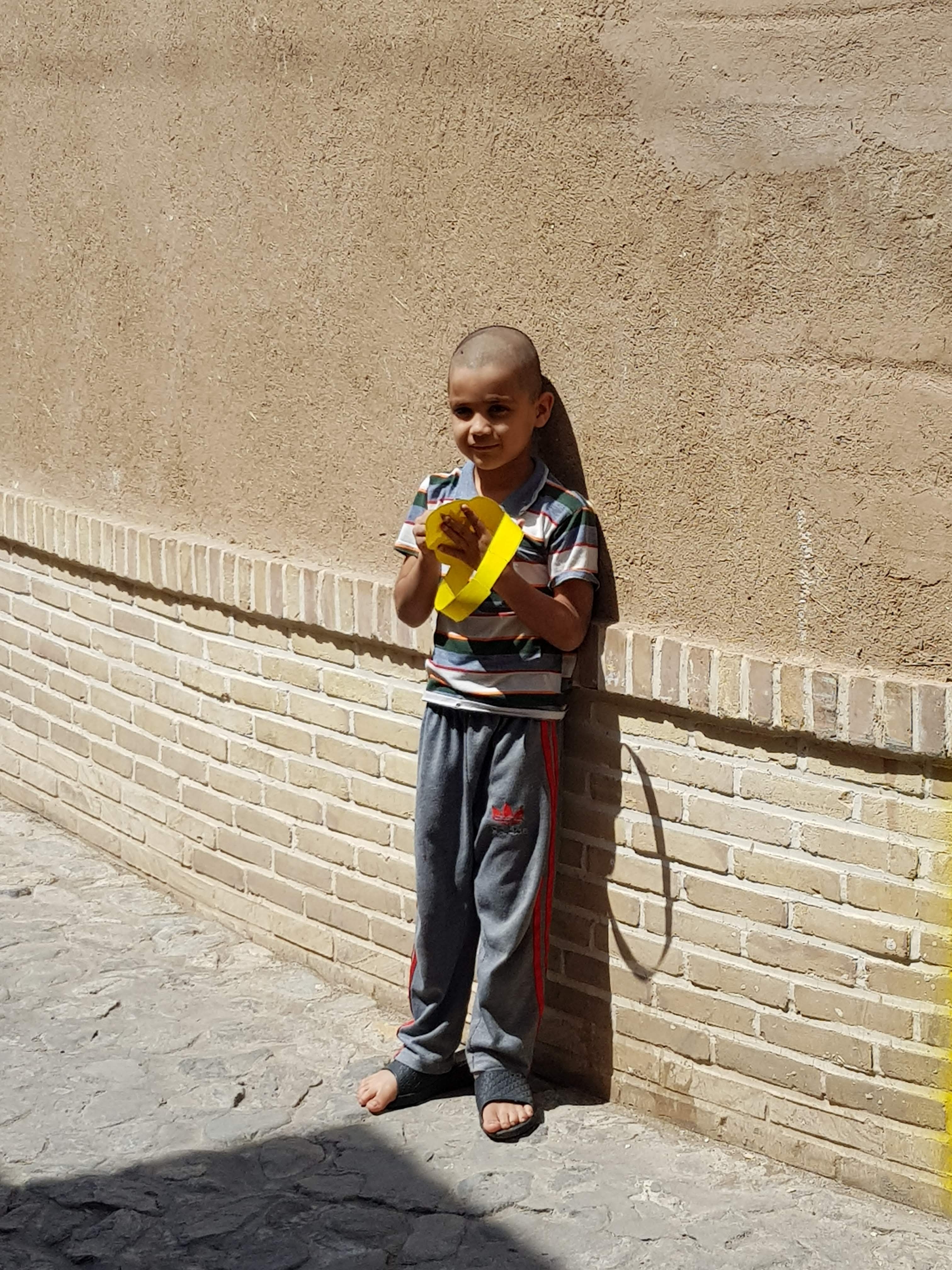> Close your eyes
> Think of a dot
> It’s never the same dot
> keep it so hard
> no matter hard you try
,.--.,_
.’`-.,, ‘.
,’ `. `,
,/ `. \
// \ \
// \ \
// \ ,
/ | , |
|/ .. | \
/| / \ \ |
| | | | | |
| | |_. | | |
| | .’ | | |
| | .’` \ / | |
| ,-` ‘- | /
,-`| / |
,-` | \ | `
_-` \ \ ` /
-` \ \ / /
\ \ / /
\ `. /,’
‘, ‘._ ,’
‘, `’--’``
`’’--’`
REBOOT of the past
In the summer of 2023, I was commissioned to participate with a new work as part of the REBOOT exhibition. This was a great moment to indulge further with modular world-building ideas that’s been brewing in the background of my head.
From early on, I knew I wanted to build a house, inspired by the architecture of traditional desert houses in Iran. Secondly, to forge this house with the mythology of Homā Bird. After I started building a modular structure around these ideas, I became convinced that the third angle is missing and that The Labyrinth.
In this post I want to break down and articulate the process involved in making Homā's Phantom. But first I’d give an introduction to each of these 3 core concepts that shaped the work.
- Homā Bird (Persian Mythology)
- Architecture of Courtyard Houses in Kashan
- The Labyrinth
1. Homā Bird (Persian Mythology)
The Homā, deeply embedded in Persian mythology, is a captivating bird symbolizing eternal life and protection. Revered as a creature of immense wisdom and healing powers, it’s often associated with themes of rejuvenation and immortality. Legends say that the Homā flies continuously, its shadow bringing fortune to those it passes over. Unlike the cyclic rebirth of the Phoenix, the Homā represents an unending life, embodying purity, and serves as a guardian figure.
 ^ Mosaic detail at the Nadir Divan-begi Madrasa in Bukhara, Uzbekistan.
^ Mosaic detail at the Nadir Divan-begi Madrasa in Bukhara, Uzbekistan.
 ^ Persepolis - Column capital in the form of griffins known to represent Homa
^ Persepolis - Column capital in the form of griffins known to represent Homa
It is said that this unique bird spends it entire life in high sky and gets down on to the ground only to feed on bones. It breeds in the sky and lays eggs when in the air which start falling down towards the land at great speed. Before the eggs hit the ground they hatch in the air and in the chick’s downward journey it develops its eyes. On reaching the vicinity of earth, the chick becomes consciousness and gives out a shrill cry with the fear of dashing to the ground to encounter death. It stabilizes its movement and takes flight upwards towards its safest sanctuary, its mother.

This mythical story about the birth of Homā as a recursive process gripped me and I kept thinking about a what if scenario! what if some of those new born Homā birds falling on the ground won’t get the chance to fly again upwards and face their death like other mortals ? perhaps on their path to falling on the ground they had a quick glimpse on earth. So I thought to make a floating house that embodies the phantom of Homā, the ghost of those Homās who faced death. afterall a house that is built virtually perhaps naturally depicts a ghost house than any other physical representation.

^ The lammergeier is a very large bird of prey. It is morphologically similar to depictions of the Huma bird
2. Architecture of Courtyard Houses in Kashan
In 2015, I went to a short trip to visit Kashan. It’s a historical city located between Tehran and Isfahan. Kashan is located in the desert, specifically on the edge of the Dasht-e Kavir, Iran’s central desert. Despite its arid surroundings, Kashan has been a thriving oasis city for centuries, thanks to its ingenious traditional systems for tapping underground water sources.
 ^ Borujerdi House
^ Borujerdi House
Kashan’s courtyard houses is unique, they primarily date back to the 18th and 19th centuries, during the Qajar era. This period is marked by a flourishing of Persian domestic architecture, with Kashan being a prominent center due to its economic prosperity and strategic location. The city’s merchants and wealthy families invested in constructing lavish homes, embodying the period’s aesthetic preferences and the functional needs of desert living.
These houses from the outside look moderate and you only see a long wall stretching across the street. though once you enter the house it reveals itself inside out! The central courtyard is where usually grounds the garden and pool, and all the rooms are built around the courtyard each connected to each other and to the courtyard. These house like many other desert houses in Iran incorporate Wind catchers, Long structures built on the rooftops, designed ingeniously to capture and channel cool breezes into buildings, providing natural ventilation and cooling.
 ^ Borujerdi Windcatchers
^ Borujerdi Windcatchers
Walking through these houses I was deeply impressed by how the house combines aesthetics with pure ingenious engineering where neither compromise each other. This layout is extremely humble from the outside, but from within it becomes a generous space for life. the courtyard also implicates interesting social interactions among the residents. becoming a hub for spontaneous interactions, while still respecting privacy. although it worths mentioning that these houses were built by the rich aristocrats of Kashan and the power dynamics perhaps wasn’t as romantic as the architecture implies, so we need to take it with a grain of salt.
 ^ Snapshot from the research article - “Analysis of the Role of Passive Energy In the Evaluation of Kashan Houses” link
^ Snapshot from the research article - “Analysis of the Role of Passive Energy In the Evaluation of Kashan Houses” link
The courtyards of the desert houses are a complete manifestation of introversion and the environment is completely different from the outside space. In this small garden, the residents have created a pleasant environment by planting beautiful trees and flowers and building a pond. The yard has been used in different ways in Iranian houses; which include:
- as a sign of privacy;
- Unifying several elements of the house;
- Multi-space connector;
- To create a green and lively environment;
- As a natural ventilator for proper wind flow;
- An important element in organizing different spaces;
- As safe and quiet privacy for the comfort of the family
3. The Labyrinth
A labyrinth is a complex, meandering path, often designed as a single, non-branching route that leads to a center, distinguishing it from a maze, which may have multiple paths and dead ends. Labyrinths have been used symbolically and practically since ancient times, appearing in various cultures around the world. Symbolically, they represent a journey or quest. Practically, they have been used in religious and ceremonial contexts, as well as meditative and contemplative practices. The intricate paths of labyrinths, whether laid out on the ground or carved into rock, encourage a focused, meditative state as one walks the path, emphasizing the journey rather than the destination.
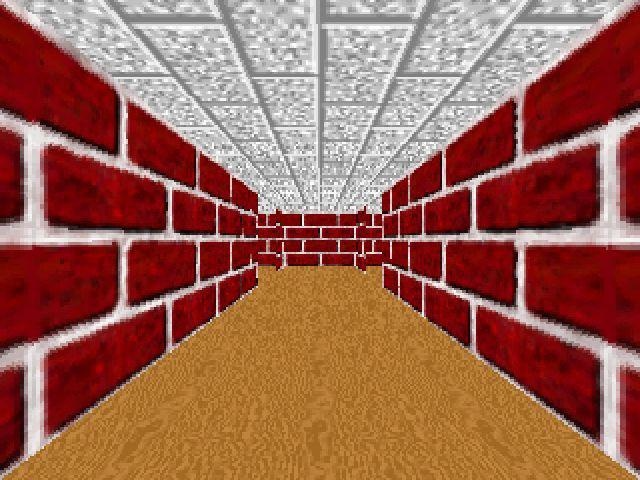
Ariadne’s thread, also known as the clew of Ariadne, is a term that stems from Greek mythology and represents a solution to a problem or a means of navigating through a complex situation. The origin story involves the hero Theseus and his journey to navigate the Labyrinth—a maze-like structure designed by Daedalus to contain the Minotaur, a fearsome creature with the body of a man and the head of a bull, located on the island of Crete.
Ariadne, the daughter of Minos, the king of Crete, falls in love with Theseus and decides to help him. She gives Theseus a ball of thread and advises him to tie one end at the entrance of the Labyrinth and unwind it as he goes deeper, enabling him to find his way back after defeating the Minotaur. Theseus follows her advice, slays the Minotaur, and uses the thread to retrace his steps out of the Labyrinth.
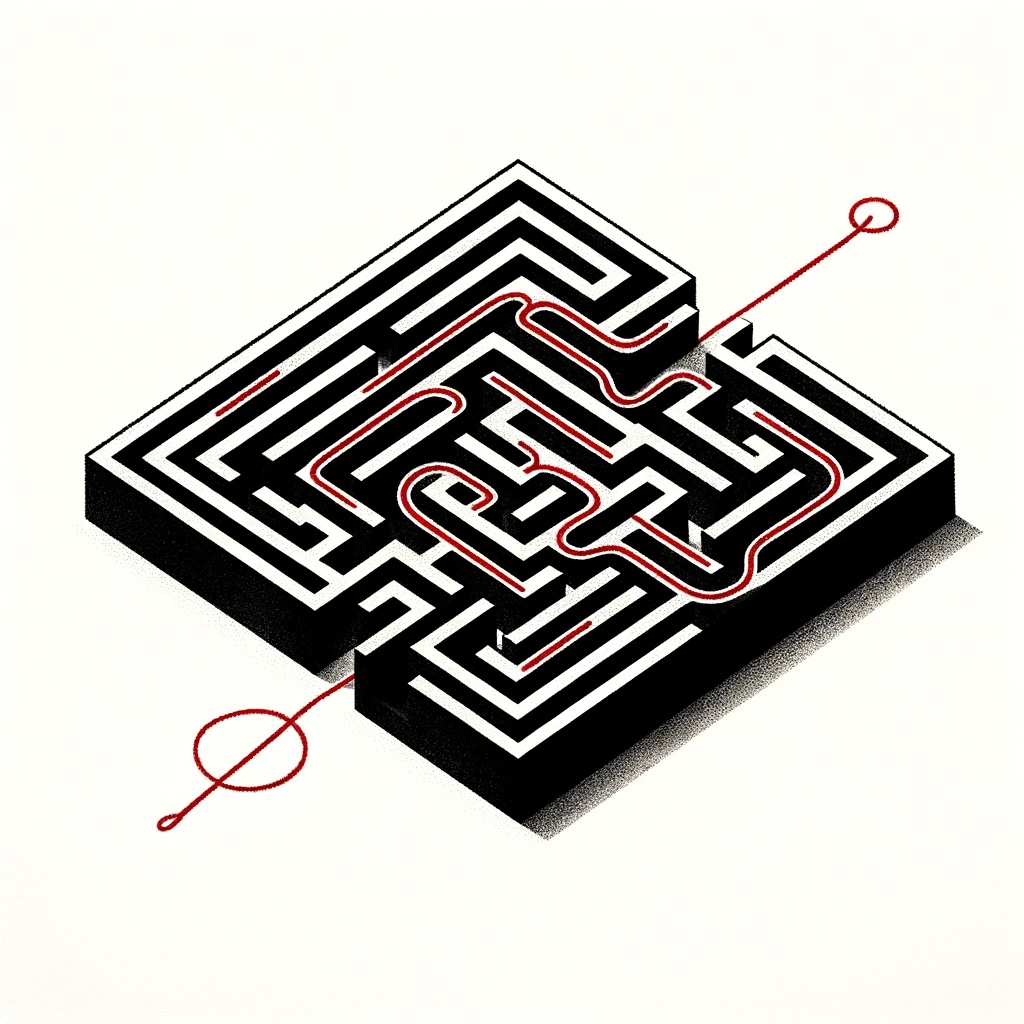
In a more abstract level, Ariadne’s Thread is seen as a technique to follow completely through to trace steps or take point by point a series of found truths in a contingent, ordered search that reaches an end position. This process can take the form of a mental record, a physical marking, or even a philosophical debate; it is the process itself that assumes the name.
In Homā’s Phantom, the user crawls the labyrinth along an invisible spatio-temporal pathway inspired by Ariadne’s thread. Here the invisible thread is a record in time of one’s way through a complex space with a simple, effective strategy.
Making the system
The aforementioned 3 concepts come together to form Homā’s Phantom, a Labyrinth Courtyard House that embodies the ghosts of Homā’s who fallen on earth. each module used making the house represents one of those fallen birds. each contain a memory fragment, a record of what the bird has seen moments before death. Below I highlight some elements that shapes this floating house.
First steps
When I start making a new level/environment in a game engine It’s all blank. I begin by adding a sky and weather system, this means we have light to begin with!
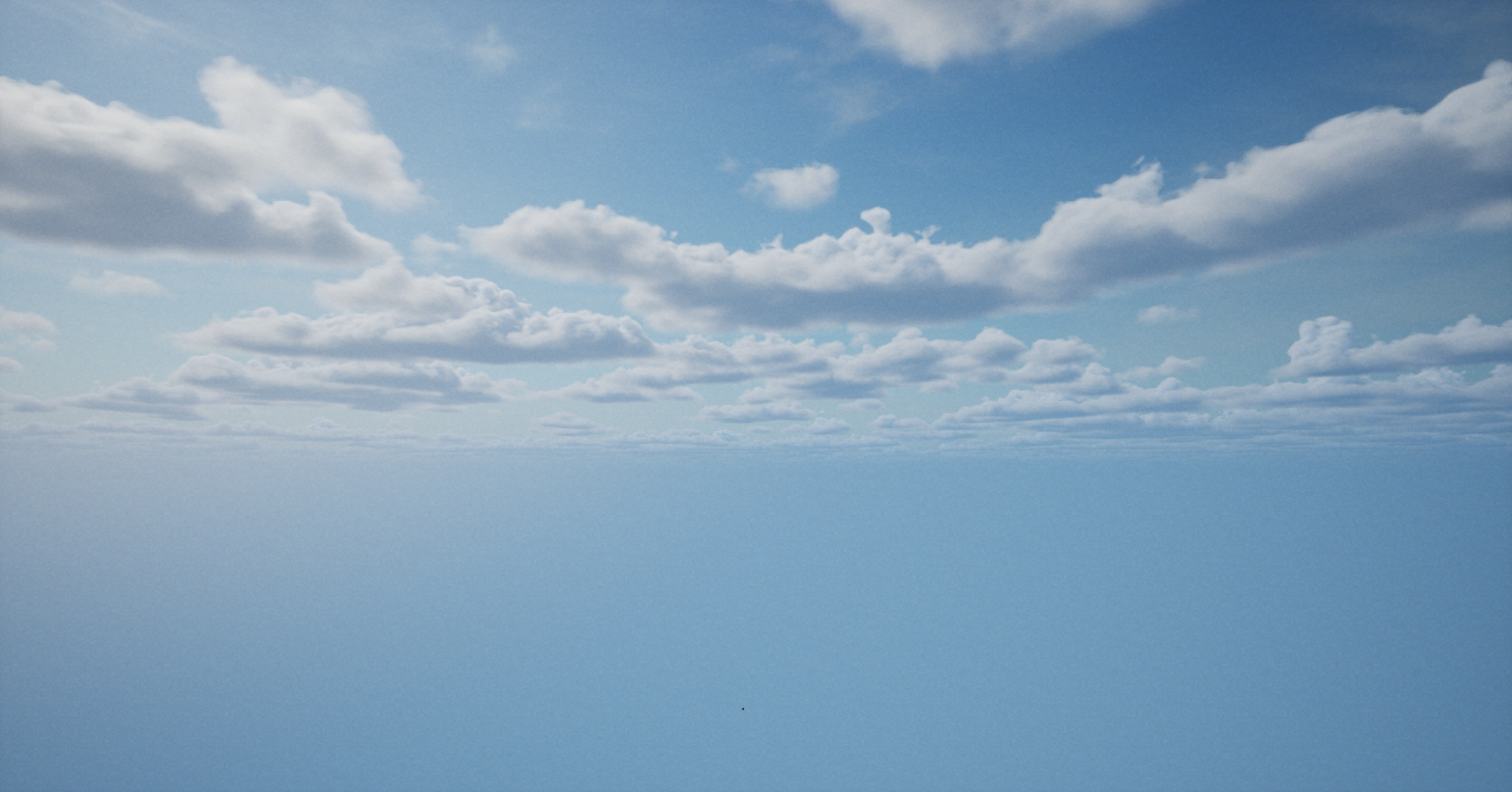
Next is to put geometries in place. I layed the simple 100cmx100cmx10cm floor all across to create a courtyard house example just to get a sense of scale and how the space can grow to a more complex layout.
After getting an initial feel of the scale, I generated a reference design of a labyrinth map using a python script. this reference was used to build the house on top.
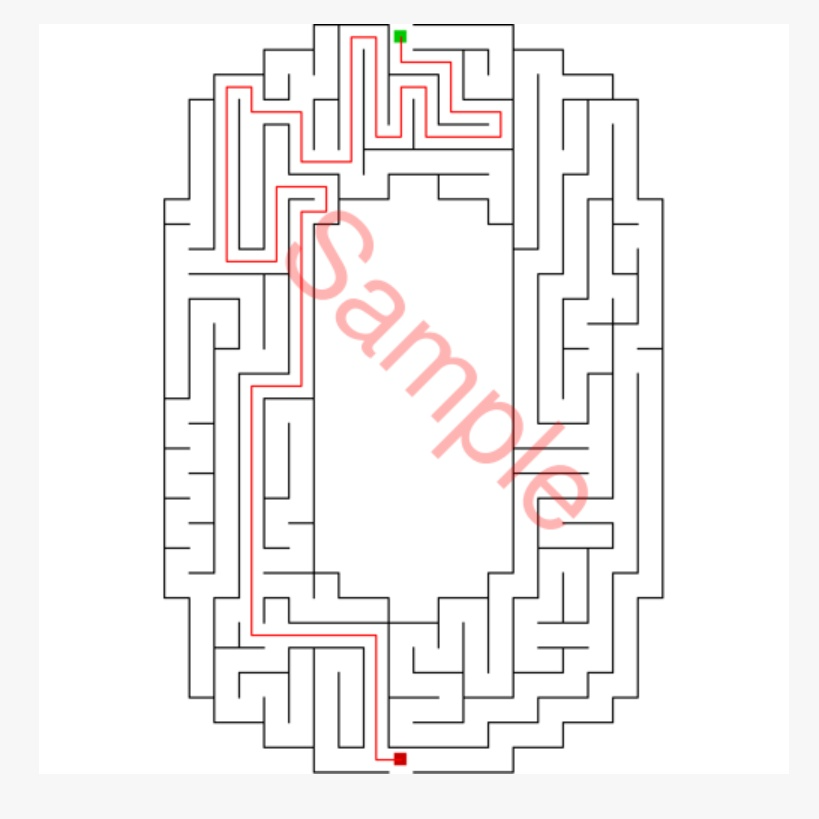
After a month of copy pasting modules the layout of the has was formed into a complex house labyrinth:
Building blocks
Making architectural modules was an iterative process. This step involved sampling some of the motifs that are commonly used in islamic architecture. such as arches with specific curves used in making vaults, domes and other kind of structures. Eventually the whole house was built using 25 unique modules. seen below:
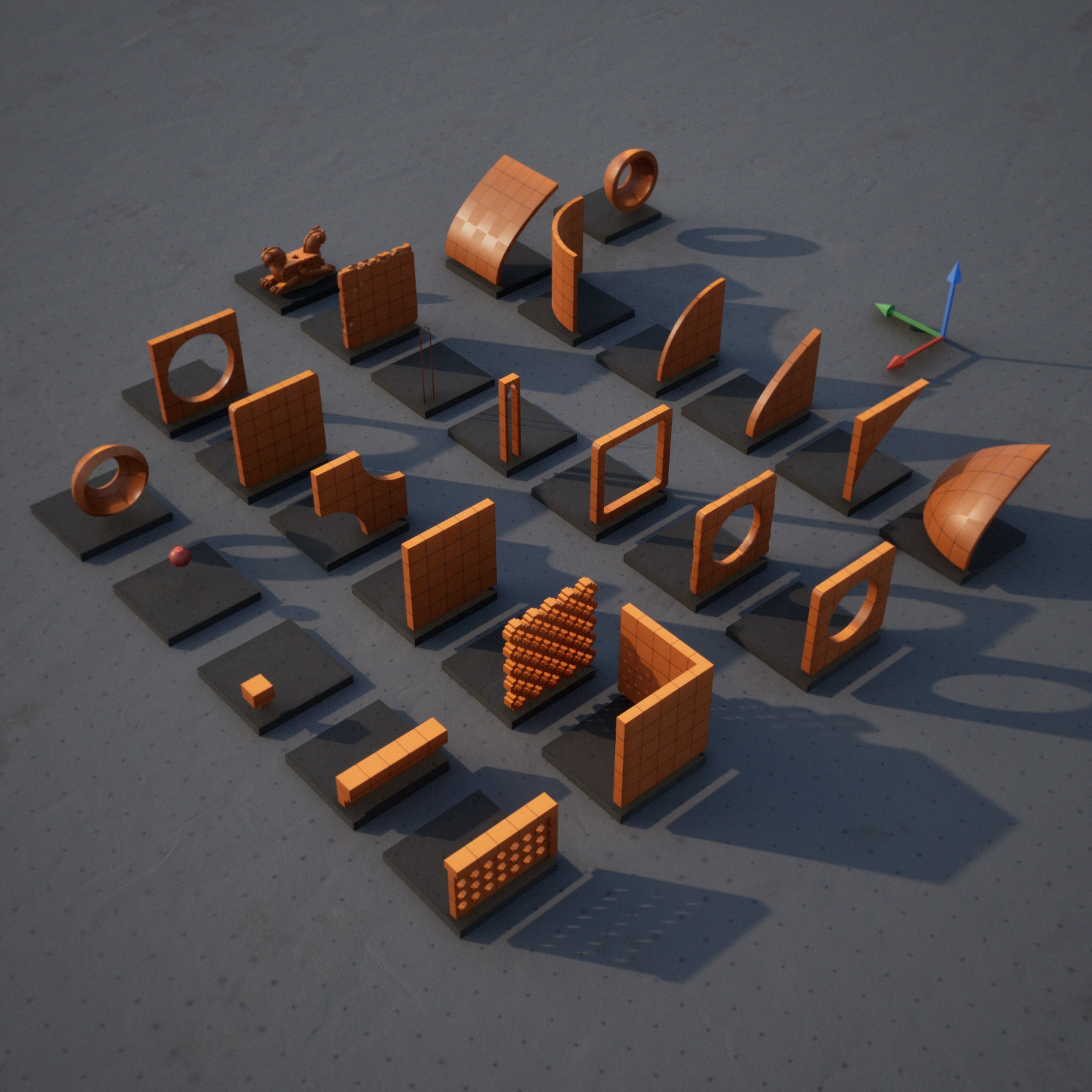
In terms of material variance I limited myself to only 4 types:
- Stucco
- Floor tiles
- Marble
- Glazed Ceramic
Having a few module goes a long way to make a complex house like this! At this stage it’s all about copy-pasting modules based on the reference, assign the desired forms to each module, rinse and repeat. through each iteration I find myself messing up with the formation of a tidy modular house and that’s where things start to become more than what they seem!
Initially, without even realizing it, I was leaning towards the symmetrical structures commonly seen in Islamic architecture. However, as the project progressed, I began experimenting with arches in unconventional ways, not typically seen or used culturally. This playful approach to space creation marked a turning point. The modules began to take on lives of their own, suggesting functions and forms beyond their traditional interpretations and normative projections.
Red ball Agent
In this work, the player or the user is a red ball crawling restlessly along the route of the labyrinth. this route takes roughly 20 minutes to complete without human intervention. However, by engaging with the trackball, participants can actively navigate the spatio-temporal pathways both forward and backward, taking control of their experience.
The red ball operates in two distinct modes:
- Automatic: Here, the ball moves under computer control, adhering to a state machine’s linear pace.
- User-Controlled: The ball awaits the player’s commands, pausing the state machine for direct interaction.

Players have four ways to interact with the environment:
-
Shooting: By pressing the projectile button, players can launch red balls. Upon contact, these balls trigger the physics system of the modules they hit, causing them to float away and disassemble, requiring significant computational resources. Overuse of this feature can strain the CPU and memory, risking a slowdown or crash of the simulation.
-
Revealing: A second button allows players to uncover text fragments within each module, sharing the final observations or notes of the Homā before its demise. These fragments are drawn from a datatable, linked to each module’s unique ID.
-
Time Navigation: By rotating the trackball, players can move through time within the labyrinth, exploring the thread at their own pace.
-
Gaze Direction: Utilizing a flight simulation joystick, players can adjust their viewpoint and aim.
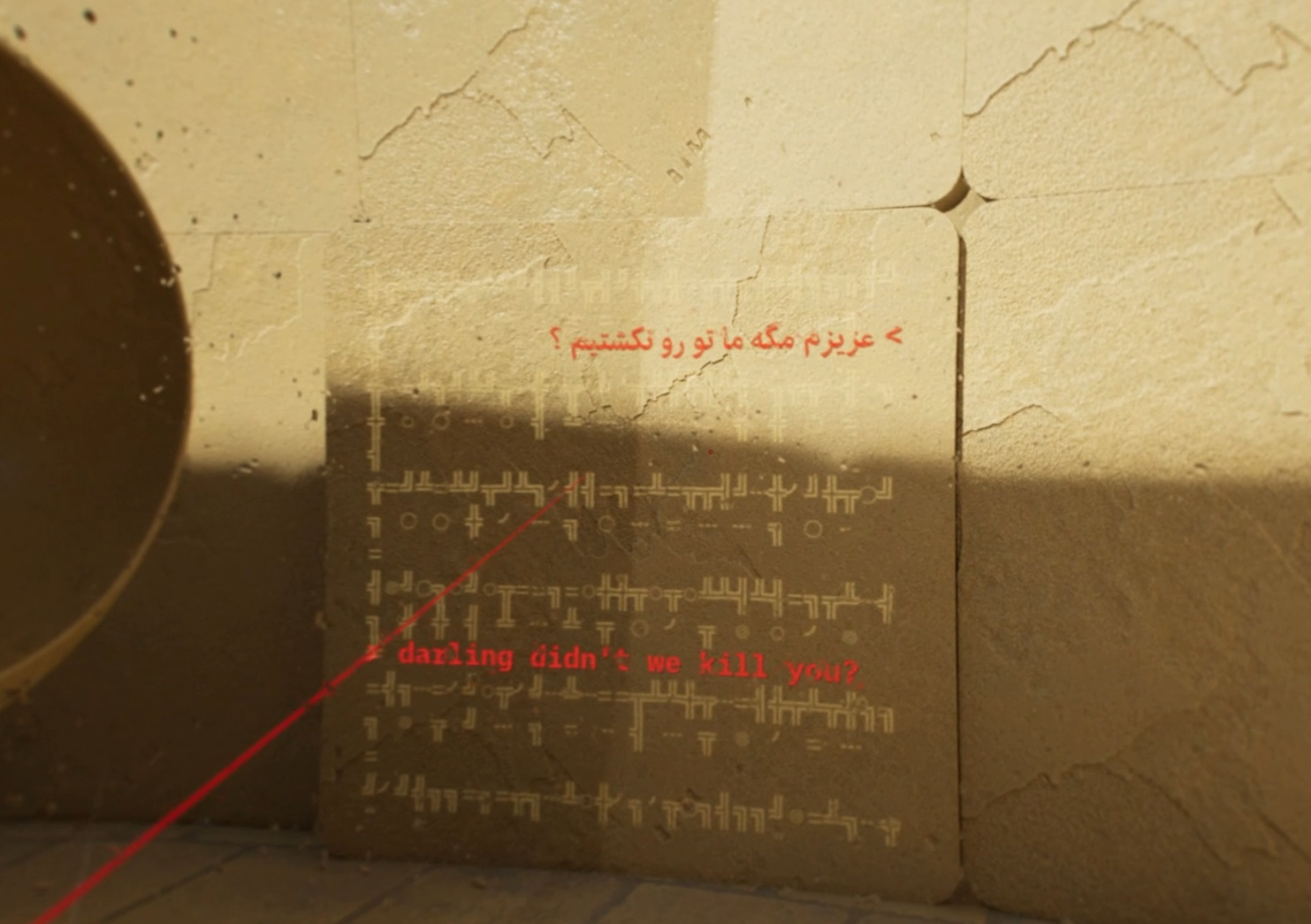

Assemblies
In Homā's Phantom, assemblies emerge as clusters of modules, some repeating or significantly prominent. These assemblies materialize, at times deliberately—like the windcatchers—and at times through spontaneous arrangement and experimentation with the modules. Often, the potential for an assembly becomes apparent simply by observing how modules inadvertently align, similar to spotting familiar shapes in cloud formations.
Windcatchers
Below is 3 different Windcatcher assemblies.
The clock
This assembly placed on top of the house’s tower mostly visible from all angles and has a simple function, it redirects a red line towards the sun. this Line is a brutal one and passes through everything on its way until it reaches the sun.
For a house that constantly flies above earth, perhaps moving as fast as an airplane, time most likely feels different. This clock would possibly be much more functional than a regular clock, because Traversing across time zones at high velocity requires constant time adjustments based on geolocation. Drawing a consistent line to the sun helps us see ourselves in this new coordination. the clock becomes a compass and all we care about in time is where we are according to the sun.
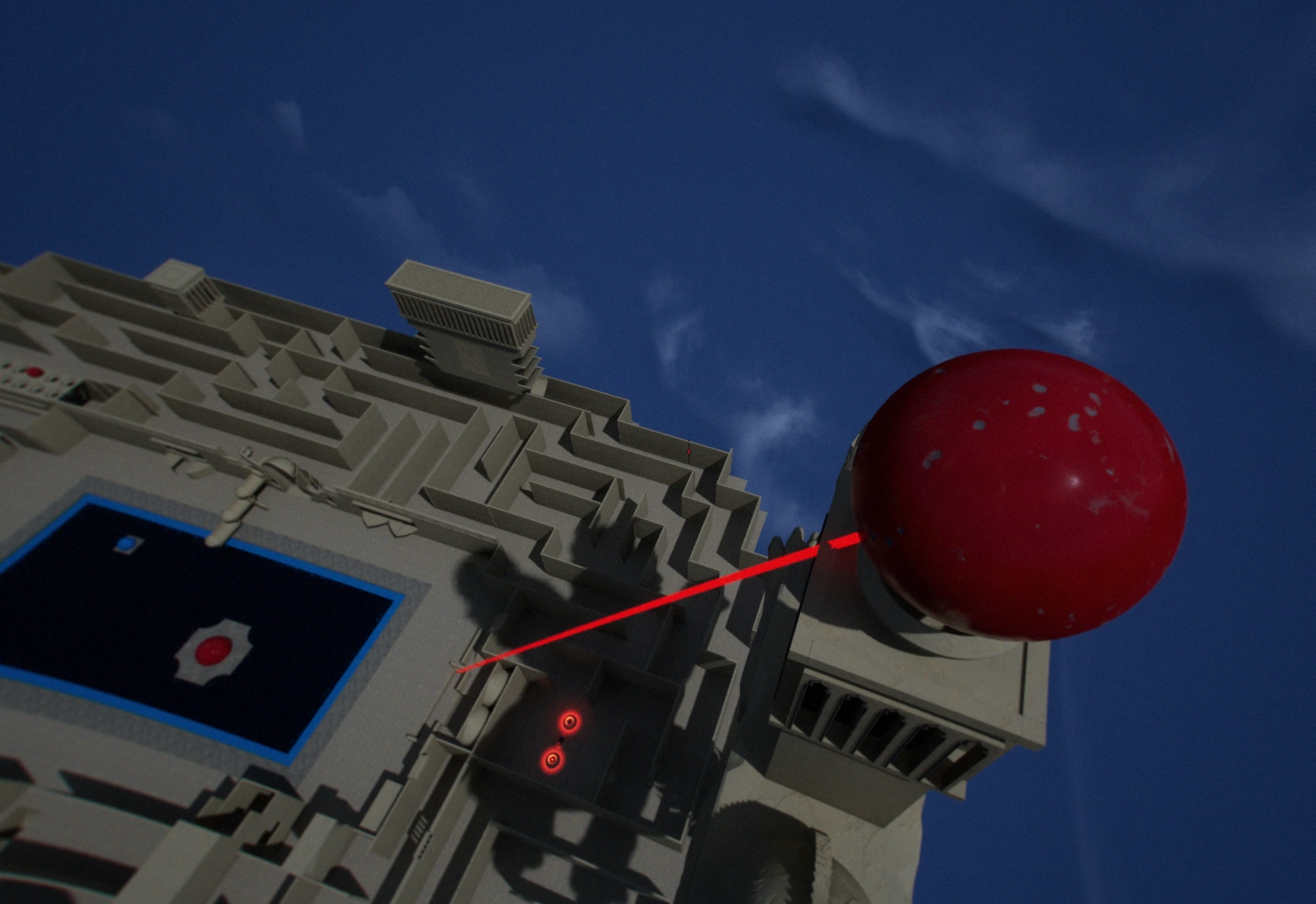
Blood Pool
This assembly is put in the entrance of the house. combining the function of a foot bath ( a small shallow pool usually put in the entrance of pools for washing feet before entering) and the tragic story of the murder of Amir Kabir at 1852 in Kashan’s Fin Garden where he spent time in exile.
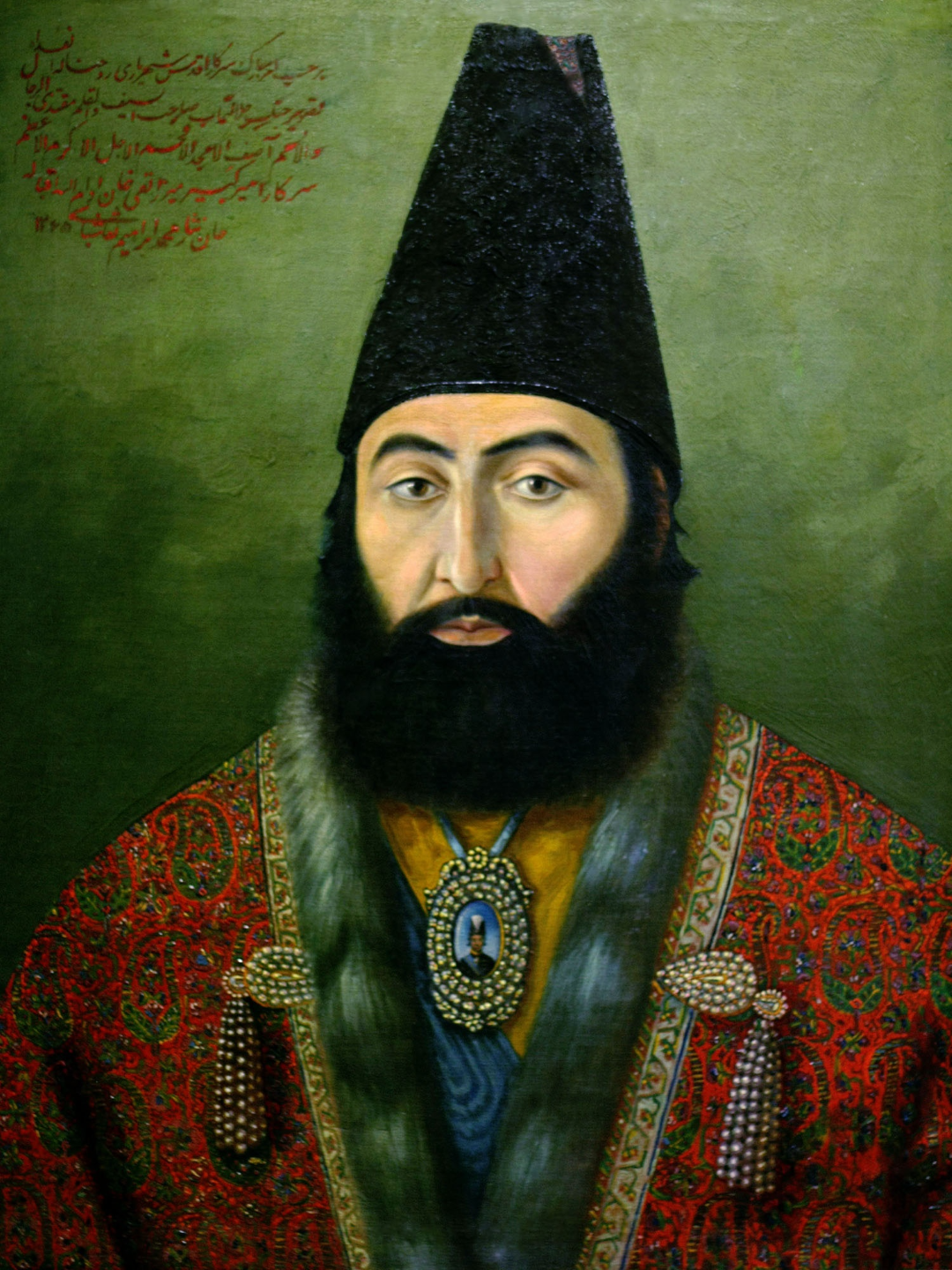
Amir Kabir was a notable figure in Iranian history, serving as the chief minister under Shah Naser al-Din Shah Qajar in the mid-19th century. Known for his progressive reforms and efforts to modernize Iran, Amir Kabir’s policies included establishing Dar ul-Funun, the first modern university in Iran, and initiating significant changes in the administrative, educational, and economic sectors. Despite his contributions, his bold reforms and increasing power drew envy and hostility from the royal court and aristocracy. His relationship with the Shah soured, leading to his dismissal and eventual arrest. Amir Kabir was murdered at Fin Garden’s bathhouse while taking a bath.
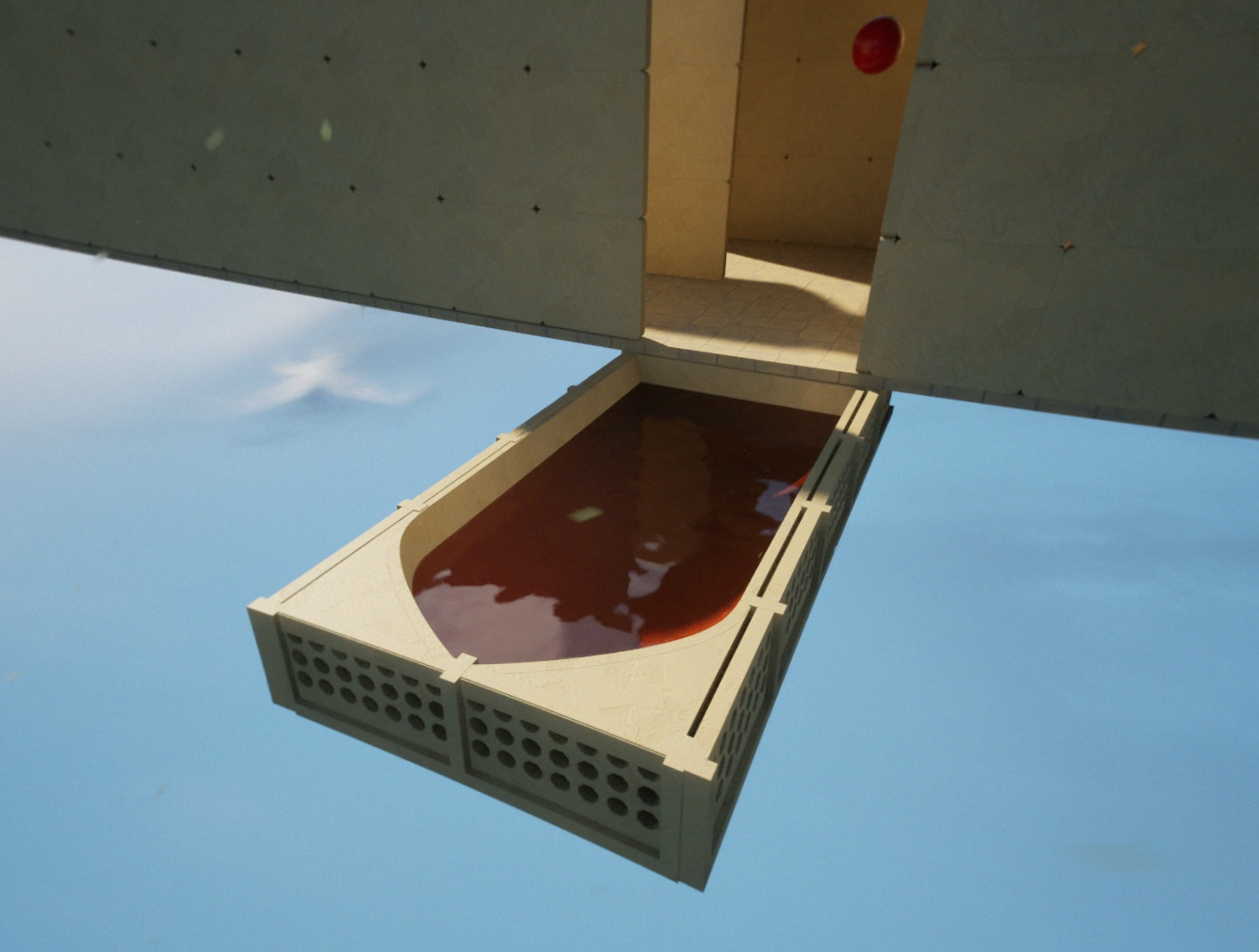
Exaptation
Exaptation, a term from evolutionary biology, describes how a trait initially developed for one purpose can be repurposed for an entirely different function. It’s the nature’s way of innovating through recycling. While this concept originated in biology, it’s equally prominent in technology and other fields.
In the natural world, bird feathers serve as a good example. What might have begun as a means for temperature regulation or display evolved into a key feature for flight.
Technologically, exaptation is also significant. For example, microwave radiation, first used in radar technology during World War II, was later adapted to cook food. NASA’s space research has yielded numerous technologies with new commercial applications, like organic recycling agents now used in food supplements. This phenomenon extends to various low-tech innovations, where existing tools are repurposed for novel uses.
“Technological innovations frequently involve the use of a process or artifact in a new context.” - Larson et al., ‘Exapting Exaptation’
In the context of Homā's Phantom, exaptation manifests in the construction and interaction with modules. Assemblies, while bearing resemblance to their origins, assume new roles within this environment. The sun clock mechanism exemplifies this, gaining a novel significance within the model. Such a mechanism, once integrated, inherently expands the conceptual boundaries of what a clock represents. This form of exaptation, emerging through modular system design, stands out as a particularly intriguing aspect of creative experimentation.
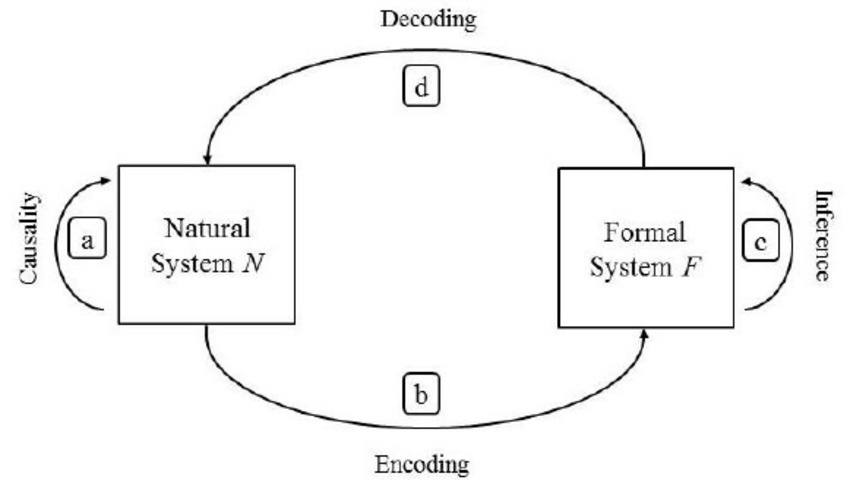
Moving ahead
We’ve reached the end of our exploration into the modular urge, but this is far from the final chapter. Up next, I’ll dive into my current research project, ModularX. This project extends the concepts and curiosities that have developed over time into a more structured investigation of modularity, computation, and complexity. In the upcoming posts, I’ll begin by laying out the initial framework and diagrams that will guide this new journey.
